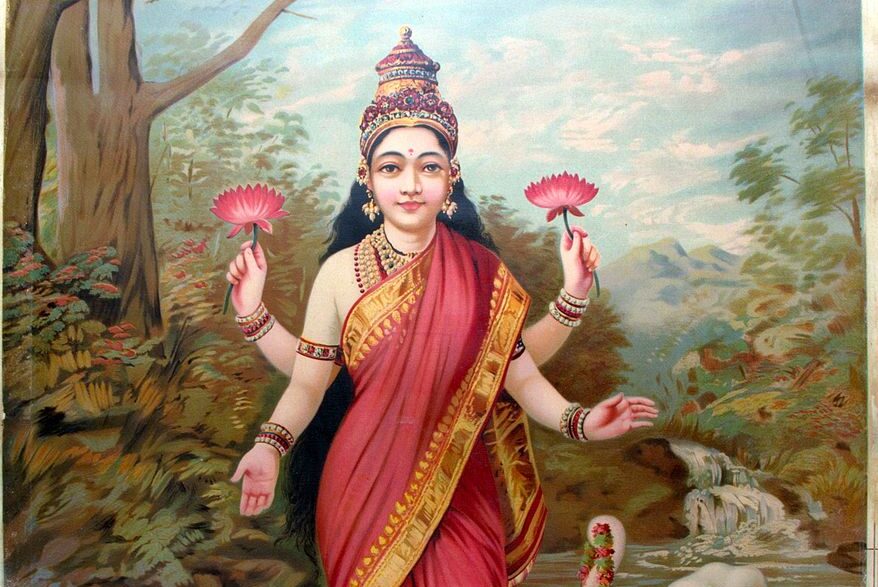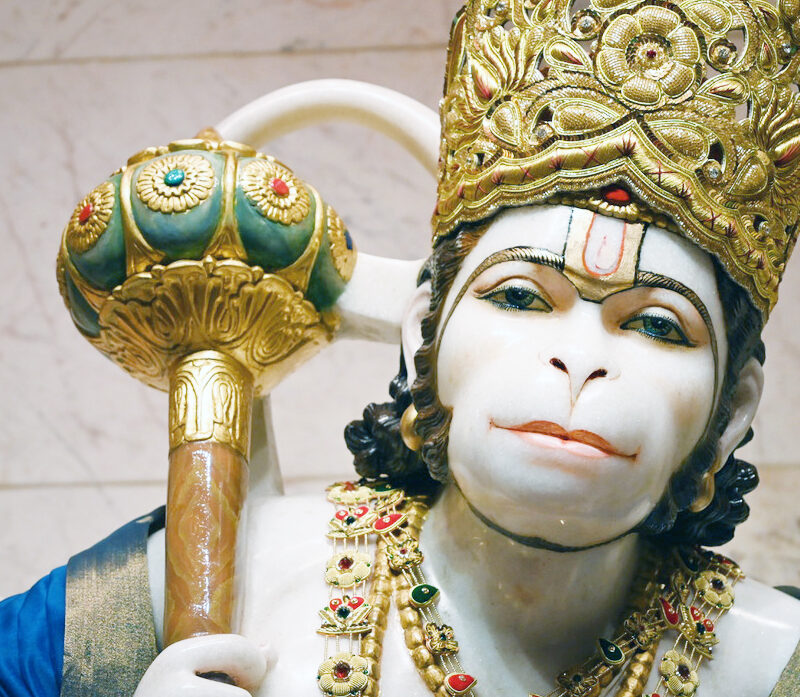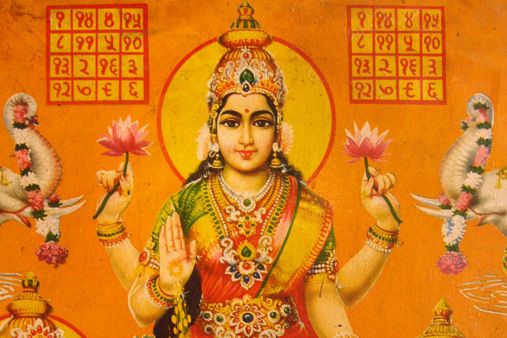
Shakti, or the creative and energetic force of the Divine, is described in Hindu traditions as being inherently feminine, manifesting in a variety of forms, with each displaying unique qualities.
Being one of these manifestations, the Goddess Lakshmi is the consort of Lord Vishnu (the sustainer of the universe), and is worshipped by Hindus as the Goddess of wealth and prosperity. As prosperity exists in a variety of ways, so too does Lakshmi, who bestows specific types of wealth through eight unique forms, known collectively as Ashta Lakshmi.
1) Adi Lakshmi
With a name derived from the Sanskrit root laksh, which means “to understand and know,” as well as “goal,” “aim,” or “objective,” Lakshmi helps people realize their goals by providing them the wealth they need in order to do so. And as adi means “first,” Adi Lakshmi is said to be her primordial form, through which she helps a person attain life’s foremost aim — freedom from the cycle of death and rebirth. She is thus known also as Moksha Pradayani, or “one who bestows liberation.”
Wearing gold jewelry and seated on a pink lotus, Adi Lakshmi is depicted with four hands — one displaying the Abhaya mudra (fingers held upwards with the palm facing outward in a gesture of fearlessness), one displaying the Varada mudra (fingers pointed downwards with the palm facing outward in a gesture of offering boons), one holding a lotus (symbolizing enlightenment and one’s duty to maintain righteousness even in unjust environs), and one holding a flag (symbolizing surrender to the Divine).
Adi Lakshmi is the embodiment of compassion and is always ready to aid those who sincerely endeavor to live every moment striving towards the ultimate spiritual aim of life.
2) Dhana Lakshmi
While the literal translation of dhana is “wealth” in terms of money, gold, property, or any other sort of tangible monetary utility, dhana also refers to qualities like willpower, strength, courage, determination, and perseverance. As such, Dhana Lakshmi is believed to show favor to those who work hard by providing the wealth and prosperity required for them to become the best versions of themselves.
Draped with jewelry and seated on a pink lotus, Dhana Lakshmi is depicted with six hands — one wielding a discus (symbolizing time, purity of mind, and protection), one with a conch (symbolizing creation), one with a bow and arrow, one with a water pitcher (symbolizing elixir of life), one with a lotus, and one in Abhaya mudra with gold coins flowing from the palm.
Dhana Lakshmi is a storehouse of all the universe’s wealth, helping to fulfill the potential of those who resolve to conquer the mind and persevere despite all difficulties.
3) Dhanya Lakshmi
Dhanya means “blessed,” and as life would be impossible without food, Dhanya Lakshmi blesses devotees with the great fortune of agricultural wealth. Devotees, in turn, show their gratitude by honoring her before partaking meals, and by selflessly offering food to others who are in need.
Portrayed in green garments that represent growth, renewal, and agricultural greenery, Dhanya Lakshmi sits on a pink lotus and is depicted with eight hands — one in Abhaya mudra, one in Varada mudra, one holding a mace (symbolizing strength), two holding lotuses, and three holding various agricultural products.
Indiscriminately providing nourishment to all, Dhanya Lakshmi highlights the importance of showing gratitude for Mother Nature’s miracles, for whether rich or poor, no one can possibly live without them.
4) Gaja Lakshmi
Worshipped as the “giver of animal wealth,” Gaja Lakshmi was traditionally of deep importance to farmers whose cows and bulls would provide dairy and till the land. Gaja, which means “elephant,” also signifies power and royalty, as elephants were regularly used by rulers of ancient India in warfare.
Flanked on either side by a white male and female elephant, Gaja Lakshmi sits on a pink lotus and is depicted with four hands — one in Abhaya mudra, one in Varada mudra, and the other two holding lotuses.
Satisfying the needs of those who earn their livelihood through the use of animals, Gaja Lakshmi’s blessings remind one of the great value such animals add to society, and how they should, therefore, not be tortured and exploited, but instead treated with love, care, and respect.
5) Santana Lakshmi
Traditionally prayed to by couples desiring children, Santana Lakshmi (santana meaning “progeny,” or “children”) symbolizes fertility.
Arrayed in gold jewelry, wearing a garland of flowers, and seated on a pink lotus, she is typically depicted with six hands — two holding pitchers of water, one holding a shield, one holding a sword, one holding a baby, and one in Abhaya mudra to dispel negativity and offer the boon of a child. Bestowing the warmth and care necessary for raising healthy and happy children, Santana Lakshmi also signifies the ferocity of a protective mother.
Fulfilling the desire for vibrant and long-living offspring, Santana Lakshmi especially blesses those who honor parenthood as a sacred duty, and who view children as being the greatest treasures of family life.
6) Veera Lakshmi
A symbol of bravery and valor, Veera Lakshmi blesses worshippers with the strength required to overcome obstacles on the path of one’s material and spiritual life.
Covered in flowers and gold ornaments, and seated on a pink lotus, she is depicted with eight hands — one with a discus, one with a bow, one with an arrow, one with a sword or trident, one with palm leaf scriptures, one with a conch, one in Varada mudra, and one in Abhaya mudra.
Wielding a medley of weapons, Veera Lakshmi is known also as Dhairya Lakshmi (dhairya meaning “courage”), who grants one the fearlessness needed to persevere through life’s ups and downs, thus favoring those who resolve to remain determined and optimistic in all circumstances.
7) Vidya Lakshmi
As vidya means “knowledge,” this is the form of Lakshmi that helps guide one’s intellectual development. Cultivating the inherent qualities residing in one’s psyche, she helps to unlock a person’s potential, allowing them to achieve both material and spiritual success.
Adorned in jewelry, Vidya Lakshmi is usually depicted with four hands — two holding lotuses, one in Abhaya mudra, and one in Varada mudra.
For those who are troubled by self-doubt and insecurity, Vidya Lakshmi brings knowledge to foster mental resilience, fortitude, and strong will. More importantly, however, she also provides divine wisdom to those who are sincerely looking to spiritually transform their lives.
8) Vijaya Lakshmi
Vijaya Lakshmi, whose first name means “victory,” is a significator of success, instilling devotees with hope and inspiration.
Clothed in red, bedecked with flowers, and seated on a lotus, Vijaya Lakshmi is depicted with eight hands — one with a discus, one with a sword, one with a shield, one with a noose, one with a conch, one with a lotus, one in Abhaya mudra, and one in Varada mudra.
Manifesting for the purpose of helping people conquer life’s impediments with tenacity and grit, Vijaya Lakshmi favors those who maintain a positive attitude in the face of all difficulties. While she can be prayed to for success in any endeavor, devotees are especially encouraged to invoke her guidance on the path of spirituality.
Though Lakshmi’s forms are distinct, her encompassing nature is that of a nurturing and protective mother whose wealth is considered to be boundless. She gives to devotees what they need, while at the same time encouraging them to work hard and persevere. Her presence can be invoked by maintaining cleanliness, offering flowers, and lighting lamps. But the best way to reach out to any Ashta Lakshmi form is simply to pray with fervent sincerity.
















































